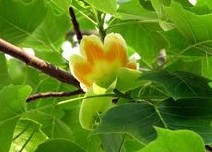Liriodendron chinense, the Chinese tulip tree, is Asia's native species in the Liriodendron genus. This native of central and southern China grows in the provinces of Anhui, Guangxi, Jiangsu, Fujian, Guizhou, Hubei, Hunan, Jiangxi, Shaanxi, Zhejiang, Sichuan and Yunnan, and also locally in northern Vietnam.
Liriodendron chinense is very similar to the American species, Liriodendron tulipifera, differing in the often slightly larger and more deeply-lobed leaves, and in the shorter inner petals in the flowers, which lack the orange pigment of L. tulipifera. The Chinese tulip tree reaches about 40 metres (130 ft) tall.
It is not as hardy as the American species, but is cultivated on other continents as an ornamental tree. It is grown in England (where there are many at Kew Gardens), Ireland, Belgium, the Netherlands, and Germany.
| Catalog | Product Name | CAS Number | Manual |
|---|---|---|---|
| CFN98715 | Liriodenine | 475-75-2 | |
| CFN98630 | Epitulipinolide diepoxide | 39815-40-2 | n/a |
| CFN98252 | Epitulipinolide | 24164-13-4 | |
| CFN97483 | Syringin pentaacetate | 92233-55-1 | n/a |
| CFN99282 | Syringin | 118-34-3 | |
| CFN98034 | Parthenolide | 20554-84-1 | |
| CFN99916 | Beta-Sitosterol | 83-46-5 | |
| CFN98009 | Syringaresinol diacetate | 1990-77-8 | |
| CFN98713 | Daucosterol | 474-58-8 | |
| CFN99453 | Cinnamic acid | 140-10-3 | |
| CFN92060 | Syringaresinol | 487-35-4 | |
| CFN96077 | 7-O-Acetyl-4-O-demethylpolysyphorin | 89706-39-8 | n/a |
A unique collection of 30 natural compounds from Senecio scandens
A unique collection of 31 natural compounds from Garcinia multiflora Champ.
A unique collection of 22 natural compounds from Ziziphus jujuba Mill. var. inermis (Bunge) Rehd.
A unique collection of 52 natural compounds from Panax ginseng C. A. Mey.
A unique collection of 22 natural compounds from Mangifera indica L.





